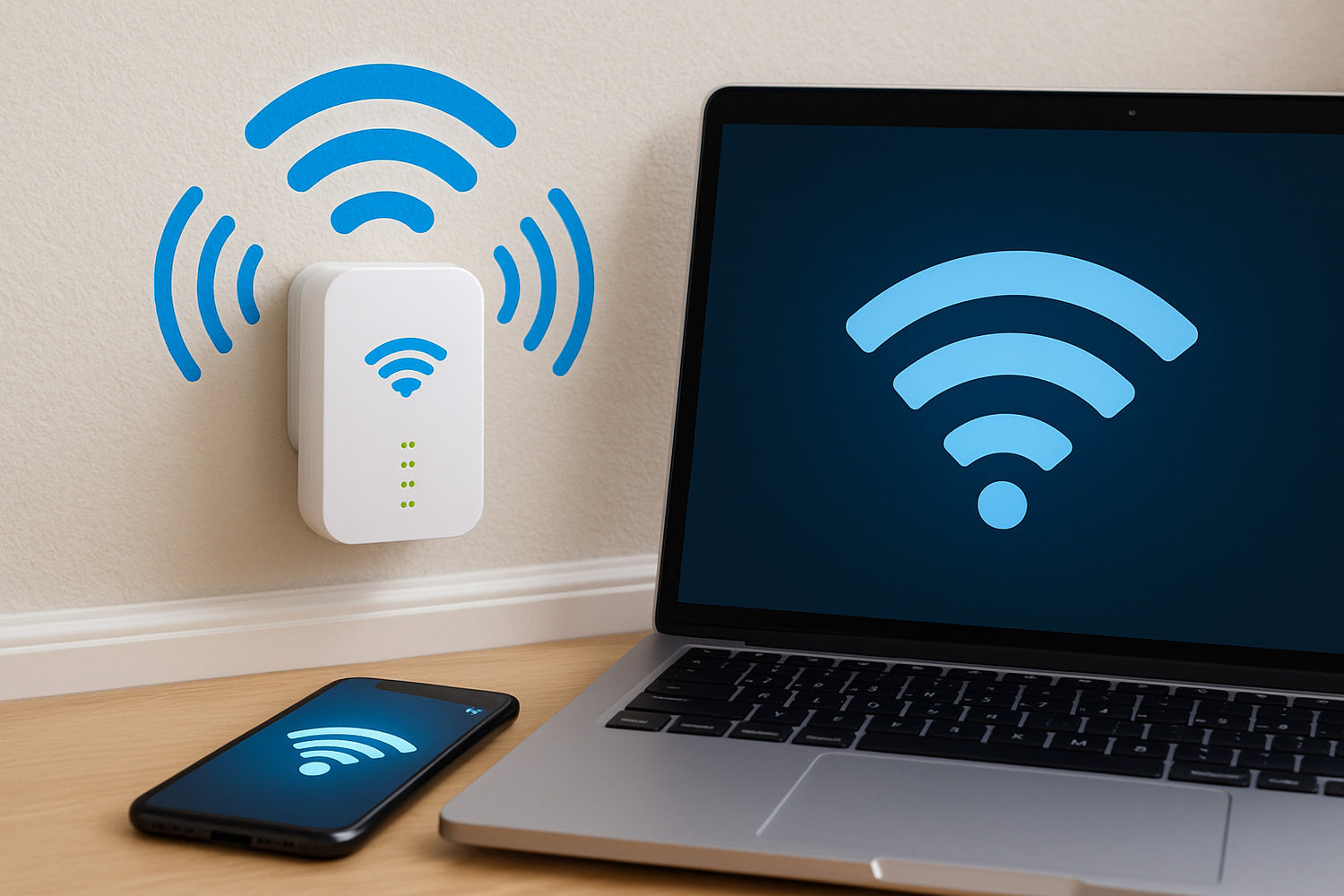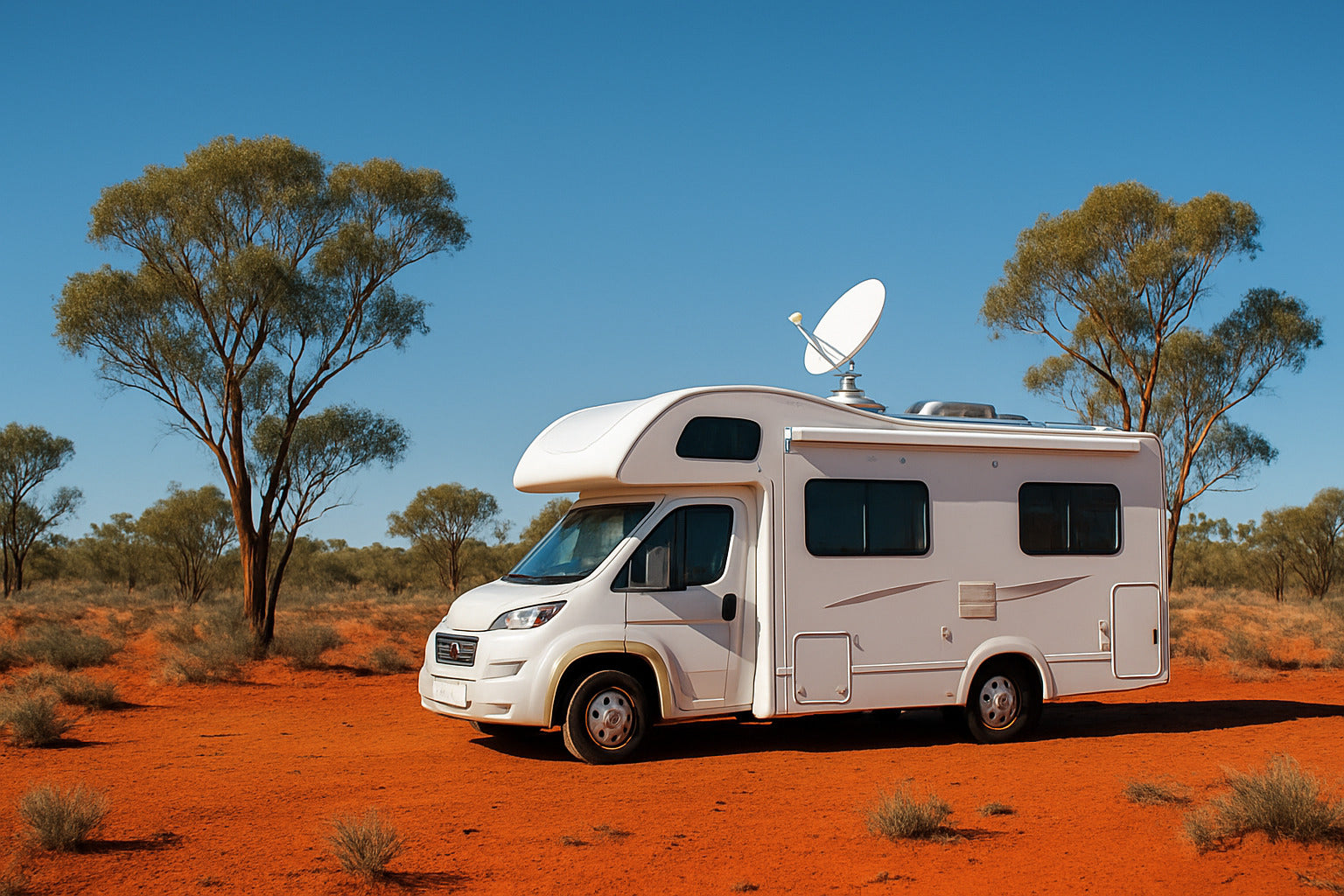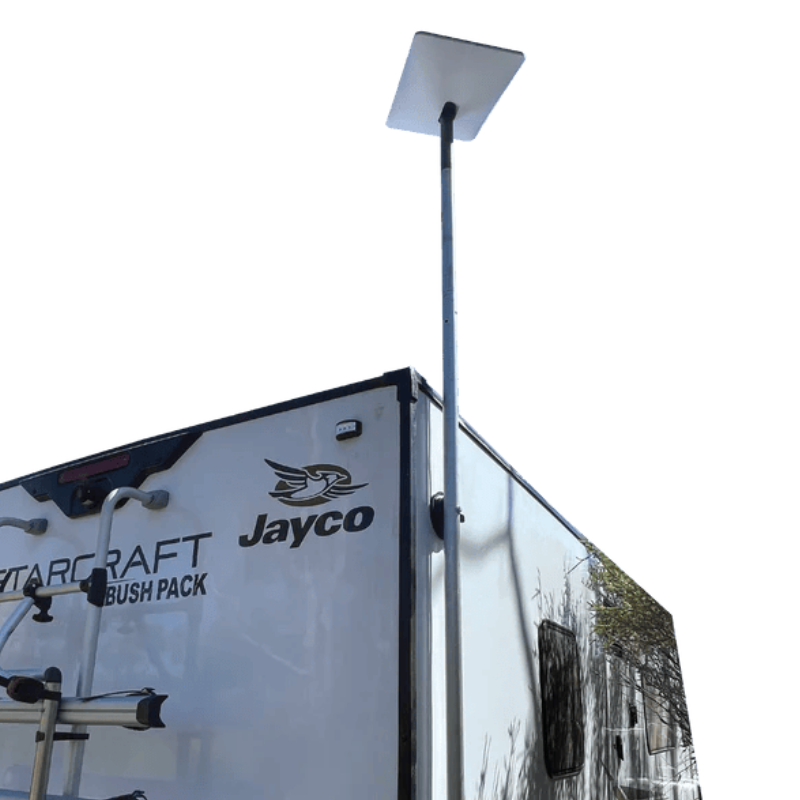Why Good WiFi Repeaters Are Essential for Remote Australian Connections
A good wifi repeater can transform your internet experience by extending your network's reach to eliminate dead zones and boost connectivity where you need it most. Here are the top considerations when choosing a WiFi repeater for Australian conditions:
Key Features to Look For:
- Wi-Fi 6 or newer - delivers faster speeds and better device handling
- Dual-band capability - 2.4GHz for range, 5GHz for speed
- Weather resistance - IP65+ rating for outdoor Australian conditions
- Easy setup - WPS button or app-based configuration
- Gigabit Ethernet port - for wired device connections
Best Applications:
- Extending Starlink coverage to sheds, caravans, or outbuildings
- Boosting signal strength in large rural properties
- Providing backup connectivity for remote work setups
Whether you're dealing with thick walls, long distances between buildings, or the harsh Australian climate, the right repeater can mean the difference between frustrating dropouts and reliable connectivity. This is especially crucial for Starlink in Australia, where users often need to extend their satellite internet coverage across large properties or to multiple structures.
Starlink for Remote Australia presents unique challenges - from weather interference to vast distances between the dish and where you actually need internet access. Remote communities often struggle with connectivity gaps that a well-placed repeater can solve without expensive infrastructure upgrades.
I'm Aaron Wroblewski, founder of SpaceTek Australia, and I've spent over 25 years working with remote communications systems across HF radio, long-range WiFi, and satellite networks. Through my experience helping Australians stay connected in challenging conditions, I've seen how a good wifi repeater can be the missing piece that transforms an unreliable internet setup into a dependable communications lifeline.

What Makes a Good WiFi Repeater in 2025?
The WiFi world has shifted dramatically over the past few years, and choosing a good wifi repeater in 2025 means understanding what actually matters for Australian conditions. After helping countless remote properties get connected, I've learned that the difference between a frustrating internet experience and reliable connectivity often comes down to picking the right repeater technology.
Dual-band capability isn't just a nice-to-have anymore—it's essential. You need that 2.4GHz band to punch through thick walls and travel long distances across your property, while the 5GHz band handles the heavy lifting for streaming and video calls.
The real game-changer for 2025 is Wi-Fi 6 and its newer siblings, Wi-Fi 6E and 7. Recent IEEE research shows that Wi-Fi 6 delivers impressive performance boosts on upload speeds. For remote workers uploading large files or hosting video conferences, this translates to noticeably faster performance—exactly what you need when you're relying on Starlink for Remote Australia.
MU-MIMO technology solves one of the biggest headaches with older repeaters. Instead of your devices taking polite turns to use the internet, MU-MIMO lets multiple devices communicate simultaneously. When you've got kids streaming, someone working from home, and smart home devices all competing for bandwidth, this technology keeps everything flowing smoothly.
Beamforming takes a smarter approach to signal distribution. Rather than broadcasting WiFi in all directions like a lighthouse, beamforming focuses the signal directly toward your devices. This targeted approach makes a huge difference across the long distances common on rural Australian properties.
The backhaul traffic handling is where modern repeaters really shine. Older models would halve your internet speed because they used the same channel for receiving and transmitting data. Today's good wifi repeater models use dedicated channels for this backhaul communication, dramatically reducing the speed penalty.
Firmware updates might sound boring, but they're crucial for remote installations where you can't afford connectivity failures. Look for manufacturers with a solid track record of ongoing support—your repeater needs to stay secure and perform reliably for years, not just months.
Repeaters vs Boosters vs Mesh: Clearing the Jargon
Let's cut through the marketing confusion and talk about what you're actually buying when you invest in a good wifi repeater.
Repeaters and boosters are essentially the same thing for most practical purposes. Both grab your router's signal and rebroadcast it to extend coverage. Manufacturers sometimes use different terms, but functionally, they're solving the same problem—getting internet to places your router can't reach effectively.
Mesh systems work differently. They create a network of nodes that communicate with each other, sharing a single network name and automatically connecting you to the strongest signal as you move around. While mesh systems generally provide superior whole-home coverage, they come with significantly higher costs and complexity.
When a Repeater Beats a Mesh Upgrade
Despite all the mesh system marketing, there are plenty of scenarios where a good wifi repeater makes more sense, particularly for Australian conditions and Starlink in Australia setups.
Budget installations top the list. When you need to solve a specific dead zone without spending hundreds on a complete mesh overhaul, quality repeaters deliver excellent value.
Rental properties present unique challenges. You can't modify the existing network infrastructure, but you still need better coverage in your living area. A plug-in repeater solves this without requiring landlord approval.
Caravans and RVs have space and power constraints that make a simple repeater more practical than multiple mesh nodes. When you're already managing limited 12V power and compact living spaces, simplicity wins.
Good WiFi Repeater Line-up for Starlink Users
At SpaceTek Australia, we've developed our repeater range specifically for the unique challenges faced by Starlink in Australia users. Our testing across diverse Australian conditions - from tropical Queensland humidity to dusty outback environments - has informed every design decision.

SpaceTek AX1800 "Ranger" – Best Overall Good WiFi Repeater
Our flagship SpaceTek AX1800 "Ranger" represents what we consider the ideal good wifi repeater for Australian conditions. Built around Wi-Fi 6 technology, it delivers 1201 Mbps on the 5GHz band plus 574 Mbps on 2.4GHz - more than sufficient for Starlink for Remote Australia applications.
The gigabit Ethernet port allows you to connect wired devices at full speed, making it perfect for connecting equipment like weather stations, security cameras, or workshop computers that need reliable connections. This becomes especially valuable in remote locations where wireless interference might affect sensitive equipment.
The upload speed boost characteristic of Wi-Fi 6 technology makes a real difference for video conferencing and cloud backup tasks common in remote work scenarios. During our testing, we consistently measured upload improvements of 30-40% compared to older AC-standard repeaters.
Starlink-friendly design includes optimised antenna patterns that work well with the low-angle satellite signals characteristic of Starlink coverage in southern Australia. The unit's internal antenna configuration reduces interference with satellite reception while maximising terrestrial WiFi coverage.
SpaceTek Outdoor AC1200 "BushMate" – Weather-proof Coverage
For truly remote applications, our SpaceTek Outdoor AC1200 "BushMate" brings good wifi repeater performance to the harshest Australian conditions. The IP67 housing provides complete protection against dust ingress and water immersion - essential for installations in agricultural, mining, or coastal environments.
Remote communities often need connectivity solutions that can survive cyclones, dust storms, and extreme temperature variations. The BushMate's ruggedised construction includes corrosion-resistant materials and sealed connectors that maintain performance in salt air, dust, and moisture.
Farm sheds and mine sites present unique challenges with metal construction that blocks WiFi signals and electrical interference from heavy machinery. The BushMate's high-gain antennas and robust signal processing overcome these obstacles while the weatherproof design ensures years of reliable operation.
The unit supports both AC power and 12V DC operation, making it suitable for solar-powered remote installations common in outback Australia.
SpaceTek Compact N300 "Nomad" – Budget Plug-and-Play
Our SpaceTek Compact N300 "Nomad" proves that a good wifi repeater doesn't require a premium price. Designed for travel-sized portability, it's perfect for caravans, temporary accommodations, and mobile work setups.
Low-power DC operation allows the Nomad to run from 12V systems common in recreational vehicles and boats. Despite its compact size, it delivers reliable 300 Mbps performance - more than adequate for streaming, video calls, and general internet use.
The plug-and-play design means setup takes minutes using WPS pairing, making it accessible even for users with limited technical experience.
Setting Up and Optimising Your Repeater
Getting the most from your good wifi repeater comes down to smart placement and proper configuration. After helping hundreds of Australians extend their Starlink coverage across rural properties, I've learned that successful repeater installation is part science, part art.
Optimal placement starts with the classic halfway rule - position your repeater roughly midway between your router and the area needing coverage. But Australian conditions throw some curveballs at this simple guideline. That corrugated iron shed might seem like the perfect spot, but metal roofing can create signal reflections that either boost or block your WiFi depending on the angle.
The line-of-sight principle makes a massive difference in real-world performance. Even partial obstructions like water tanks, machinery, or thick timber posts can cut your signal strength dramatically. During our field testing across Queensland cattle stations, we found that moving a repeater just a few metres to clear a direct path often doubled the effective range.
Channel mapping becomes crucial when you're not the only network in the area. Mining camps, neighbouring properties, and even passing caravans can create interference on popular channels. Your smartphone's WiFi analyser app will show you which channels are crowded and which are clear.

Troubleshooting Common Issues with a Good WiFi Repeater
Speed drops top the list of repeater complaints, but they're often avoidable with proper setup. Traditional repeaters do reduce speed because they're juggling communication with both your router and your devices using the same radio. Modern good wifi repeater units minimise this through dedicated backhaul channels and smarter traffic management.
Double-NAT problems pop up when your repeater starts acting like a separate router instead of extending your existing network. Make sure your repeater is set to "bridge" or "extender" mode rather than "router" mode during setup.
LED status lights are your first diagnostic tool when things go wrong. Most repeaters use colour-coded lights to show signal strength, connection status, and operating mode.
Security & Privacy Essentials
WPA3 encryption gives you the strongest available protection for your extended network. While older WPA2 is still common and functional, WPA3 provides better defence against password attacks and improved privacy.
Setting up a guest network through your repeater lets you share internet access without exposing your main network. This becomes particularly valuable in remote locations where you might regularly host workers or family members who need temporary access.
Firmware patching addresses security vulnerabilities as they're found. Enable automatic updates if your repeater supports them, or establish a regular manual update routine.
For comprehensive guidance on network and IoT security, including WiFi repeater security considerations, the CISA cybersecurity resources provide regularly updated best practices and threat information.
Starlink in Remote Australia: Maximising Range with Repeaters
Starlink for Remote Australia brings satellite internet to places that traditional broadband simply can't reach, but it also creates some interesting challenges when it comes to getting that signal where you actually need it. Unlike your typical home internet that arrives neatly at your front door, Starlink's dish often needs to be positioned in the most inconvenient spots imaginable.
Picture this: your Starlink dish performs best on that hill behind your house with the clearest view of the sky, but your home office is 200 metres away down in the valley. Or maybe the only spot without tree interference is on your machinery shed, but you actually need internet in the homestead. This is where a good wifi repeater becomes absolutely essential for making your Starlink investment work properly.
The dish alignment requirements for optimal Starlink performance rarely coincide with convenient WiFi coverage. We've seen setups where the perfect satellite reception spot is half a kilometre from the main residence. Running cables that distance isn't just expensive - it's often impractical across rocky terrain or existing infrastructure.
Obstruction mapping using Starlink's mobile app helps you find that sweet spot for satellite reception, but it doesn't solve the connectivity gap between your dish and where you're actually trying to work. The app might tell you to put your dish on the highest point of your property, which could be nowhere near your house, workshop, or accommodation blocks.
This is where our SpaceTek approach makes a real difference. We've designed our good wifi repeater solutions specifically for the unique patterns and characteristics of Starlink signals. The low-angle satellite coverage that's typical for Starlink in Australia requires different antenna optimisation compared to traditional terrestrial internet sources.
Weather impacts add another layer of complexity to the equation. During heavy rain or dust storms, your Starlink signal naturally weakens - that's just physics. But when your signal is already travelling through multiple hops to reach your devices, any weather-related degradation gets amplified.
The SpaceTek rust-proof mounts we've developed support both your Starlink dish and WiFi repeaters as an integrated system. Australian conditions are tough on outdoor electronics - from the salt spray on the coast to the red dust inland, and the extreme temperature swings everywhere in between.

Upgrades Beyond a Repeater
While a good wifi repeater solves the immediate coverage challenge, some installations benefit from additional upgrades that work hand-in-hand with your repeater setup.
Higher mast installations serve double duty - they improve both your Starlink's satellite reception and your WiFi repeater's terrestrial coverage. Getting both pieces of equipment lifted above ground-level obstacles can dramatically improve overall performance.
DC power supply systems become crucial for truly remote installations where mains power is either unavailable or unreliable. A properly designed DC power system lets your internet keep running from solar panels or battery banks when the grid goes down.
Surge protectors might seem like a small detail, but they're absolutely essential for protecting your investment. Australian thunderstorms can send surges through power lines that will damage sensitive electronics.
Real-World Performance Snapshots
Our outback station deployment showcases what's possible with properly integrated systems. A 50,000-hectare cattle station in Western Australia needed connectivity from the homestead out to worker accommodation and facilities spread across several kilometres. Using strategically placed SpaceTek repeaters, the system now provides reliable Starlink for Remote Australia coverage.
The coastal caravan park installation in Queensland presents different challenges with salt air and tropical humidity. The weather-resistant repeaters extend Starlink coverage across 15 hectares of camping sites, providing reliable internet that keeps working even when the weather turns nasty.
Our regional school network implementation in the Northern Territory demonstrates how these systems support critical services. The remote school extends Starlink for Remote Communities connectivity to portable classrooms using our repeater network.
For guidance on WiFi antenna installations and compliance requirements in Australia, the ACMA provides comprehensive resources that ensure your setup meets regulatory standards while maximising performance.
Frequently Asked Questions about Good WiFi Repeaters
Do repeaters halve my Starlink speed?
This is probably the most common concern we hear from customers. The good news is that modern good wifi repeater units are much smarter than their older cousins from a few years back.
Yes, there's typically some speed reduction - but it's not the dramatic 50% cut that many people fear. Quality dual-band repeaters use separate channels for talking to your router versus connecting to your devices.
In our real-world testing across various Australian properties, well-positioned repeaters typically maintain 60-80% of your original speed while bringing connectivity to areas that previously had none at all. When you think about it, having 60% of your Starlink for Remote Australia speed in your workshop or caravan is infinitely better than having zero connectivity out there.
For most everyday activities - streaming Netflix, video calls with the grandkids, or checking weather reports - this reduced speed remains perfectly adequate. The trade-off is almost always worthwhile when you consider the alternative is no internet at all in those dead zones.
Where do I place a good wifi repeater in a tin-roof house?
The classic Australian tin-roof challenge! I've dealt with this scenario countless times, and metal roofing definitely keeps us on our toes when it comes to WiFi placement.
The key insight is that metal roofing can actually work for you if you understand how it behaves. Rather than just blocking signals, tin roofs create reflection patterns that can improve coverage when you work with them instead of against them.
Your good wifi repeater needs breathing room from metal surfaces - aim for at least 30 centimetres of clearance from tin walls or roofing. I've found that interior placement often works much better than trying to punch through metal barriers.
Window placement can be your secret weapon if the windows face toward both your main router and the areas needing coverage. Glass creates much less signal interference than metal construction materials.
Can I chain multiple repeaters without hurting latency?
This question comes up a lot for Starlink for Remote Communities where properties might span several kilometres. The short answer is yes, you can chain repeaters, but it requires thoughtful planning.
Each additional repeater in the chain typically adds 10-20 milliseconds of latency, which sounds scary but remains perfectly acceptable for most applications. You'll hardly notice it for web browsing, streaming, or video calls.
For remote Australian properties where coverage areas might stretch across vast distances, strategic repeater chaining can provide connectivity to areas that would be impossible to reach with a single unit. The trick is using the minimum number of hops necessary and ensuring each repeater maintains strong signal strength.
If you're dealing with a particularly challenging installation across multiple buildings or extreme distances, don't hesitate to contact our team for specific advice on your setup.
Reliable Internet Starts with the Right Accessories
When you're dealing with the challenges of remote connectivity in Australia, success isn't just about having great equipment - it's about having the right support system to keep everything working reliably, year after year. At SpaceTek Australia, we've learned this lesson through decades of helping Australians stay connected in some of the most challenging conditions on earth.
Your good wifi repeater is only as reliable as the infrastructure supporting it. That's why we've developed our Starlink accessories built for remote Australia with the same attention to detail that goes into our repeater designs. Every mounting bracket, surge protector, and weatherproof enclosure has been tested against the full spectrum of Australian conditions - from the relentless sun of the outback to the salt spray of coastal installations.
Our rust-resistant mounting systems represent years of refinement based on real-world feedback from customers across the continent. We use marine-grade stainless steel and protective coatings because we've seen what happens to inferior materials after a few seasons of Australian weather. These mounts don't just support your Starlink dish and WiFi repeaters - they protect your entire investment by maintaining structural integrity when cyclones hit, bushfires rage, or temperature swings test every joint and fastener.

What makes our approach different is understanding that Starlink in Australia faces unique challenges that don't exist in other markets. The vast distances, extreme weather, and often complete lack of backup connectivity options mean that when your system fails, help might be days or weeks away. That's why redundancy and durability aren't just nice features - they're essential requirements.
Whether you're setting up connectivity for a remote homestead where the nearest neighbour is 50 kilometres away, a mining operation that operates around the clock, or a community facility that serves as a lifeline for dozens of families, the combination of quality repeaters and proper mounting systems creates the foundation for communications you can actually depend on.
The reality of Starlink for Remote Communities is that these installations often become critical infrastructure. When the local school needs distance learning capability, when the medical clinic requires telehealth connections, or when emergency services need reliable communications during disasters, your connectivity setup becomes more than just a convenience - it becomes essential infrastructure that people's lives and livelihoods depend on.
For personalised advice on your specific connectivity challenges, or to discuss custom mounting solutions that match your unique installation requirements, contact our team at SpaceTek Australia. We've helped solve connectivity puzzles from tropical Queensland to the arid centre, and we understand that every remote location has its own specific challenges and requirements.
The investment in a good wifi repeater paired with proper mounting accessories and surge protection isn't just about better internet speeds - it's about creating a communications system that works when you need it most. In remote Australia, where the nearest repair technician might be hundreds of kilometres away, reliability isn't a luxury - it's the difference between staying connected to the world and being completely cut off when things go wrong.
For guidance on antenna installations and regulatory compliance, the Australian Communications and Media Authority provides comprehensive resources for both commercial and residential installations.




Leave a comment
This site is protected by hCaptcha and the hCaptcha Privacy Policy and Terms of Service apply.